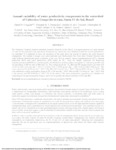Please use this identifier to cite or link to this item:
http://www.alice.cnptia.embrapa.br/alice/handle/doc/1059756Full metadata record
| DC Field | Value | Language |
|---|---|---|
| dc.contributor.author | COAGUILA, D. N. | pt_BR |
| dc.contributor.author | HERNANDEZ, F. B. T. | pt_BR |
| dc.contributor.author | TEIXEIRA, A. H. de C. | pt_BR |
| dc.contributor.author | NEALE, C. M. | pt_BR |
| dc.contributor.author | FRANCO, A. M. | pt_BR |
| dc.contributor.author | LEIVAS, J. F. | pt_BR |
| dc.date.accessioned | 2017-01-02T11:11:11Z | pt_BR |
| dc.date.available | 2017-01-02T11:11:11Z | pt_BR |
| dc.date.created | 2017-01-02 | pt_BR |
| dc.date.issued | 2016 | pt_BR |
| dc.identifier.citation | Proceedings of SPIE - International Society for Optical Engineering, v. 9998, p. 99981E-1 - 99981E-10, 2016. | pt_BR |
| dc.identifier.uri | http://www.alice.cnptia.embrapa.br/alice/handle/doc/1059756 | pt_BR |
| dc.description | The Cabeceira Comprida stream's watershed, located in Santa Fé do Sul, Brazil, is an agroecosystem with great demand of water for the population and agriculture. During the dry season the water demand exceeds the amount generated by the watershed. It is important to know the dynamics of the water above the ground to improve the water resources management. Ten Landsat 8 images were used combined with Northwestern São Paulo State Weather Network data under different thermohydrological conditions of the year 2014 to quantify actual evapotranspiration (ETa), biomass production (BIO) and water productivity (WP) based on ETa. Using the Simple Algorithm for Retrieving evapotranspiration (SAFER) for calculating ETa, the Monteith's radiation model was applied for estimating the BIO and for calculation of WP the ratio of BIO and ETa. The average pixels for ETa, BIO and WP ranged respectively from 0.38 ± 0.35 to 2.05 ± 0.76 mm day-1; 10.15 ± 12.19 to 71.61 ± 35.54 kg ha-1 day-1; 1.89 ± 0.76 to 3.88 ± 0.86 kg m-3. The lower values of ETa (0.38 mm day-1; DOY 220), BIO (10.15 kg ha-1 day-1; DOY 220) and WP (1.89 kg m-3; DOY 204) were obtained in winter, and highest values of ETa (2.05 mm day-1; DOY 364) and BIO (71.64 kg ha-1 day-1; DOY 364) in the summer and WP (3.88 kg m-3; DOY 92) in the autumn. The water productivity components can subsidize the monitoring of the agro-ecosystems, being a useful tool to quantify the annual variability of ETa and BIO. | pt_BR |
| dc.language.iso | eng | eng |
| dc.rights | openAccess | eng |
| dc.subject | Actual evapotranspiration | pt_BR |
| dc.subject | SAFER | pt_BR |
| dc.subject | Evapotranspiração real | pt_BR |
| dc.subject | Produção de biomassa | pt_BR |
| dc.subject | Landsat 8 | pt_BR |
| dc.title | Annual variability of water productivity components in the watershed of Cabeceira Comprida stream, Santa Fé do Sul, Brazil. | pt_BR |
| dc.type | Artigo de periódico | pt_BR |
| dc.date.updated | 2017-05-30T11:11:11Z | pt_BR |
| dc.subject.nalthesaurus | biomass production | pt_BR |
| riaa.ainfo.id | 1059756 | pt_BR |
| riaa.ainfo.lastupdate | 2017-05-30 | pt_BR |
| dc.identifier.doi | 10.1117/12.2242007 | eng |
| dc.contributor.institution | Daniel N. Coaguila, UNESP; Fernando B. T. Hernandez, UNESP; ANTONIO HERIBERTO DE C TEIXEIRA, CNPM; Christopher M. Neale, Water for Food Global Institute at the University of Nebraska; Renato A. M. Franco, UNESP; JANICE FREITAS LEIVAS, CNPM. | pt_BR |
| Appears in Collections: | Artigo em periódico indexado (CNPM)  | |
Files in This Item:
| File | Description | Size | Format | |
|---|---|---|---|---|
| PofSPIEHERIBERTOSantaFe.pdf | 1,82 MB | Adobe PDF |  View/Open |









